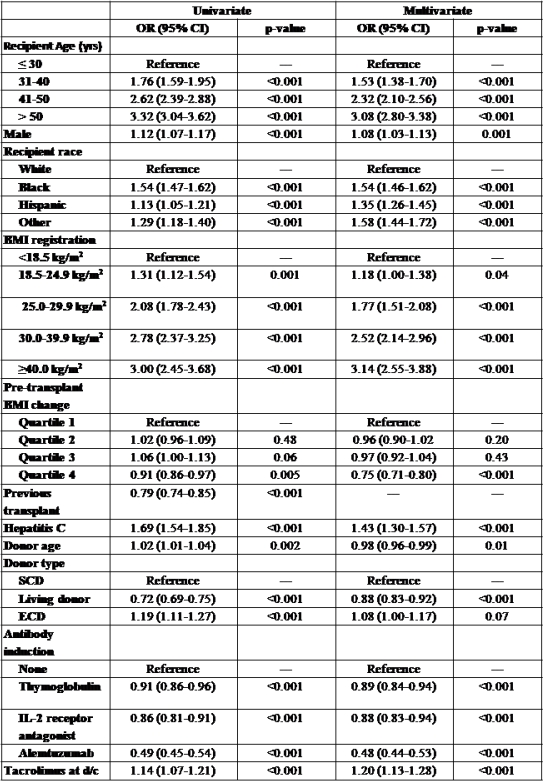Pre-Transplant Weight Change and New-Onset Diabetes After Kidney Transplantation
E. Huang, B. Abdalla, M. Andre, S. Bunnapradist.
Dept of Medicine, UCLA School of Medicine, Los Angeles, CA.
Meeting: 2015 American Transplant Congress
Abstract number: A178
Keywords: Kidney transplantation, Metabolic complications, Obesity
Session Information
Session Name: Poster Session A: Kidney: Cardiovascular and Metabolic
Session Type: Poster Session
Date: Saturday, May 2, 2015
Session Time: 5:30pm-7:30pm
 Presentation Time: 5:30pm-7:30pm
Presentation Time: 5:30pm-7:30pm
Location: Exhibit Hall E
Background:
We studied the association between pre-transplant weight change and new-onset diabetes after kidney transplant (NODAT).
Methods:
Using OPTN/UNOS data with follow-up to October, 2012, all adult (age>18 years) kidney recipients between 2004-2010 were identified, excluding those with diabetes (DM) before transplant. Recipients without DM at waitlisting later identified as diabetic on recipient follow-up represented the NODAT group (n=9681). The comparison group was recipients without DM (n=61,992). Pre-transplant weight change was defined as the percentage difference in body mass index (BMI, kg/m2) between waitlisting and transplant [{(BMI at registration-BMI at transplant)/BMI at registration} x 100]. Recipients were stratified into quartiles according to pre-transplant weight change (Quartile 1=highest weight gain–>Quartile 4=highest weight loss). Factors associated with NODAT were assessed with multivariate logistic regression.
Results:
Recipients with NODAT were older and more likely to be male, black, have hepatitis C, and maintained on tacrolimus-based immunosuppression. NODAT recipients had a higher median BMI than no DM (at registration: 27.8 vs. 25.8 kg/m2; at transplant: 28.0 vs. 25.9 kg/m2, p<0.001). The percentage change in BMI was similar, albeit statistically different (NODAT, median (IQR): 0% (-4.4%, 3.0%); no DM 0% (-4.4%, 3.5%); p=0.02). On multivariate analysis, there was a graded association between increasing BMI and NODAT (Table 1). Recipients with the highest weight loss (Quartile 4) were at decreased odds compared to those with the highest weight gain (Quartile 1). Based on the multivariate model, the predicted probability of NODAT ranged from 9.2-23.5% for Quartile 1 compared to 7.1-18.9% for Quartile 4 (Figure 1, p<0.001).
Conclusion:
Pre-transplant weight loss was associated with decreased odds of NODAT.


To cite this abstract in AMA style:
Huang E, Abdalla B, Andre M, Bunnapradist S. Pre-Transplant Weight Change and New-Onset Diabetes After Kidney Transplantation [abstract]. Am J Transplant. 2015; 15 (suppl 3). https://atcmeetingabstracts.com/abstract/pre-transplant-weight-change-and-new-onset-diabetes-after-kidney-transplantation/. Accessed December 19, 2025.« Back to 2015 American Transplant Congress
